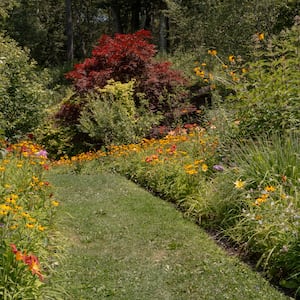Health
Cultivating Wellness: How to Create a Healing Garden This Spring

As spring approaches, gardening enthusiasts are encouraged to explore the health benefits of cultivating a garden that not only beautifies outdoor spaces but also fosters well-being. Research indicates that gardening activities, such as shoveling and weeding, can lower rates of hypertension and heart disease while enhancing mental health. Furthermore, engagement with nature may positively influence the human microbiome.
Many gardeners overlook the potential of their plants to provide medicinal benefits, according to herbalist and blogger Devon Young, author of *The Homegrown Herbal Apothecary*. She notes that common backyard plants, from roses to hibiscus and even Douglas fir needles, possess various health benefits. However, caution is necessary, as some plants can be toxic to humans and pets. Reliable online resources, including the Lady Bird Johnson Wildflower Center and the Plants for a Future database, can assist gardeners in identifying safe options.
Choosing Native Plants for a Healing Garden
For those looking to create a garden that supports physical well-being, Bridghe McCracken, founder of Helia Land Design in West Stockbridge, Massachusetts, recommends prioritizing native plants. Native species are typically low-maintenance, requiring less water and fertilizer, and they contribute positively to local ecosystems. McCracken emphasizes that gardens featuring native plants can provide vital habitats for pollinators and other beneficial insects.
“I always suggest working with native plants because they create a garden that supports bees, butterflies, and a whole spectrum of insects,” McCracken explains. She highlights the advantages of plants like purple angelica, Echinacea, and various types of Monarda, known as bee balm, which can serve multiple purposes, from antiseptics to cold remedies.
Selecting the right combination of herbs, flowers, and shrubs involves understanding the local environment. McCracken advises listening to the land and observing which plants thrive in specific conditions. In her garden, she places tea plants used for herbal brews away from the house, allowing her to enjoy their beauty without the pressure of harvesting.
Designing with Purpose
Design aesthetics are equally important in creating a wellness garden. Ethan Dropkin, a horticulture specialist at Larry Weaner Landscape Associates in Pennsylvania, emphasizes the balance between beauty and functionality in garden design. His firm focuses on creating human-centric areas close to homes while allowing naturalistic landscapes further away.
Dropkin notes that many native plants have medicinal properties, including various native mints and yarrow, which possesses antibacterial qualities. “You can use yarrow leaves on cuts or as a poultice, and it also makes a lovely tea,” he explains.
The preparation of herbal remedies can vary based on the type of plant. Young points out that delicate plants with thin leaves can be air-dried, while more succulent varieties may require a dehydrator. “I like to use the whole plant — roots, stems, leaves, and flowers,” she adds, highlighting the versatility of Echinacea and Rudbeckia in her herbal practices.
Interest in wellness gardens extends beyond personal health. Dara Saville, author of *The Ecology of Herbal Medicine* and founder of Albuquerque Herbalism, notes that many individuals are seeking alternative healing methods. Her students often include those with chronic health issues who are taking proactive steps toward wellness. Saville describes her gardening style as “feral,” allowing plants to dictate their placement.
Her top recommendation, yerba mansa, is known for its broad therapeutic benefits, including support for the urinary and digestive systems. “It’s antimicrobial and anti-inflammatory, making it a valuable addition to any garden,” Saville states.
Bringing Native Plants to Life
The visual appeal of native plants is equally significant in promoting wellness. Mihalis Petrou, a landscape designer in New York City, has dedicated his efforts to showcasing native flora. After transforming an abandoned lot in Astoria, Queens, he now utilizes over 400 species of flowering natives in his designs.
Petrou incorporates these plants into fashion photo shoots for prominent brands and magazines, emphasizing the connection between beauty and health. “Gardening and fashion intersect; when you feel good about your environment, it sparks positive energy,” he explains.
Both Young and Petrou agree on the therapeutic nature of gardening. “Art is therapy, and landscaping is art,” Young articulates. “Creating a beautiful wellness garden is, in itself, a form of medicine.”
By fostering a connection with nature through gardening, individuals can cultivate not just plants, but also a holistic approach to health and well-being this spring.
-

 World4 months ago
World4 months agoTest Your Knowledge: Take the Herald’s Afternoon Quiz Today
-

 Sports4 months ago
Sports4 months agoPM Faces Backlash from Fans During Netball Trophy Ceremony
-

 Lifestyle4 months ago
Lifestyle4 months agoDunedin Designers Win Top Award at Hokonui Fashion Event
-

 Entertainment5 months ago
Entertainment5 months agoExperience the Excitement of ‘Chief of War’ in Oʻahu
-

 Sports4 months ago
Sports4 months agoLiam Lawson Launches New Era for Racing Bulls with Strong Start
-

 World5 months ago
World5 months agoCoalition Forms to Preserve Māori Wards in Hawke’s Bay
-

 Health4 months ago
Health4 months agoWalking Faster Offers Major Health Benefits for Older Adults
-

 Lifestyle4 months ago
Lifestyle4 months agoDisney Fan Reveals Dress Code Tips for Park Visitors
-

 Politics4 months ago
Politics4 months agoScots Rally with Humor and Music to Protest Trump’s Visit
-

 Top Stories5 months ago
Top Stories5 months agoUK and India Finalize Trade Deal to Boost Economic Ties
-

 Health2 months ago
Health2 months agoRadio Host Jay-Jay Feeney’s Partner Secures Visa to Stay in NZ
-

 World5 months ago
World5 months agoHuntly Begins Water Pipe Flushing to Resolve Brown Water Issue









